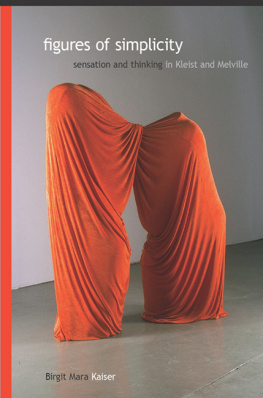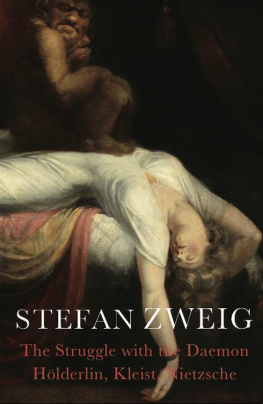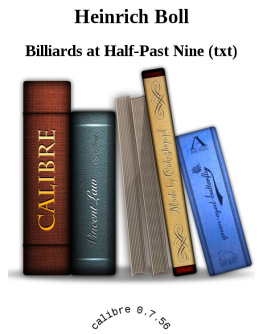SUNY series, Intersections: Philosophy and Critical Theory
Rodolphe Gasch
Figures of Simplicity
Sensation and Thinking
in Kleist and Melville
Birgit Mara Kaiser

Published by State University of New York Press, Albany
2011 State University of New York
Cover illustration, photograph of The Match (2003, fabric and Styrofoam) by Frances Bagley. Reproduced with permission of the artist.
All rights reserved
Printed in the United States of America
No part of this book may be used or reproduced in any manner whatsoever without written permission. No part of this book may be stored in a retrieval system or transmitted in any form or by any means including electronic, electrostatic, magnetic tape, mechanical, photocopying, recording, or otherwise without the prior permission in writing of the publisher.
For information, contact State University of New York Press, Albany, NY
www.sunypress.edu
Production by Kelli W. LeRoux
Marketing by Michael Campochiaro
Library of Congress Cataloging-in-Publication Data
Kaiser, Birgit Mara.
Figures of simplicity : sensation and thinking in Kleist and Melville / Birgit Mara Kaiser.
p. cm. (Suny series, intersections: philosophy and critical theory)
Includes bibliographical references and index.
ISBN 978-1-4384-3229-8 (hardcover : alk. paper)
1. Melville, Herman, 18191891Criticism and interpretation. 2. Kleist, Heinrich von, 17771811Criticism and interpretation. 3. Thought and thinking in literature.
4. Senses and sensation in literature. 5. Literature, ComparativeAmerican and German.
6. Literature, ComparativeGerman and American. I. Title.
PS2388.T53K35 2010
813'.3dc22
2009054369
10 9 8 7 6 5 4 3 2 1
Il y a deux manires de dpasser la figuration (c'est--dire la fois l'illustratif
et le narratif): ou bien vers la forme abstraite, ou bien vers la Figure.
Cette voie de la Figure, Czanne lui donne un nom simple: la sensation.
La Figure, c'est la forme sensible rapporte la sensation.
La sensation, c'est le contraire du facile et du tout fait, du clich, mais aussi
du sensationnel , du spontan, etc. La sensation a une face tourne vers
le sujet [] et une face tourne vers l'objet []. Ou plutt elle n'a pas de
faces du tout, elle est les deux choses indissolublement [].
Gilles Deleuze, Francis Bacon.
Logique de la Sensation
Acknowledgments
As it is the case with any work, this book could not have been written without the support, help, and positive energy of many people. First and foremost, I would like to thank Anselm Haverkamp, who accompanied this project from the start. Without his confidence in its first outlines, and his encouragement throughout, which always came at the right moments, this book would not have been possible. He taught me a perspective on literature that continues to be an inspiration far beyond the narrow scopes of this project, and for which I am deeply grateful. I am also indebted to the members of my dissertation committee Cyrus R. K. Patell, Mikhail Iampolski, Nancy Ruttenberg, and Paul Fleming for their criticisms on a first draft of this book, as well as for the inspiring courses I took with them at NYU and the stimulating discussions, both personal and intellectual, that resulted from them. I would especially like to thank Nancy Ruttenberg for her enthusiasm for my project and for her professional support when it was most needed. I am also grateful to Avital Ronell for the inspiration of her teaching, which was one of the most energizing parts of my graduate studies at NYU.
I would like to thank the DFG Graduate Program RepresentationRhetoricKnowledge at the European University Viadrina in Frankfurt (Oder), Germany for granting me the opportunity to finish my dissertation on a DFG-scholarship. The lively intellectual context of this remarkable circle of scholars was perfectly suited to my writing, and provided the right mixture of critique, correction, and inspiration.
It is an incredible honor to be part of a publication series that has established such long-standing and high standards in theoretical debates as Intersections: Philosophy and Critical Theory, and I am thus very grateful to its editor, Rodolphe Gasch, for his interest in my project and the opportunity to be included in his series. In this context, I would also like to thank James Peltz, Kelli WilliamsLeRoux and Andrew Kenyon at SUNY Press for their professional support, openness, and patience throughout the process of publication.
This book could not have come to fruition without the help of many friends who were, and continue to be, an intellectual and personal inspiration. They offered balanced, insightful, thought-provoking input for this book, and among them, I would especially like to thank Thomas Khurana, Dirk Setton, and Katrin Trstedt for their careful readings of early versions of the chapters, Leonard Lawlor for his critique and encouragement, Monika Lanz for her incredible effort to polish what is not my mother-tongue, and Barbara Thiele and Cornelia Thiele for their meticulous and joyful way of going again and again through the written manuscript in search for yet another tidbit to correct. I would also like to thank Emy Koopman for her help with the index.
And last but not least, I would like to thank my parents and my brother for their loving support, and for their confidence in what I was doing, without which it would have been much harder to finish this project in good spirit. My most heartfelt gratitude, however, goes to Kathrin Thiele, for her love, the sharpness of her mind and her challenges to my thinking. Without her, work and life would not by far be as rich. I am grateful that she shares both with me.
Abbreviations
| Alexander Gottlieb Baumgarten, sthetik, vol. 1, ed. and trans. Dagmar Mirbach. Hamburg: Felix Meiner, 2007 |
| ADE | Heinrich von Kleist, An Abyss Deep Enough: The Life of Heinrich von Kleist in his Parables, Essays and Letters, ed. and trans. Philip B. Miller. Boston: Dutton Books, 1982 |
| BB | Herman Melville, Bartleby, the Scrivener, in Herman Melville, The Piazza Tales and Other Prose Pieces 1839-1860, ed. Harrison Hayford, Alma A. MacDougall, G. Thomas Tanselle et al. Evanston/Chicago: Northwestern University Press, 1987 |
| BBS | Herman Melville, Billy Budd, Sailor (An inside narrative), ed. Harrison Hayford and Merton M. Sealts Jr. Chicago: University of Chicago Press, 1962 |
| BC | Herman Melville, Benito Cereno, in Herman Melville, The Piazza Tales and Other Prose Pieces 1839-1860, ed. Harrison Hayford, Alma MacDougall, G. Thomas Tanselle et al. Evanston/Chicago: Northwestern University Press, 1987 |
| BF | Gilles Deleuze, Bartleby; or, The Formula, in Essays Critical and Clinical. Minneapolis: University of Minnesota Press, 1997 |
| BSD | Heinrich von Kleist, The Betrothal in Santo Domingo, in The Marquise of Oand Other Stories, trans. David Luke and Nigel Reeves. London: Penguin, 2004 |
| CPR | Immanuel Kant, Critique of Pure Reason. Amherst: Prometheus Books, 1990 |
| F | Gilles Deleuze, The Fold: Leibniz and the Baroque. Minneapolis: University of Minnesota Press, 1988. |
| J | Herman Melville, The Writings of Herman Melville. Journals, ed. Howard C. Horsford with Lynn Horth. Evanston/Chicago: Northwestern University Press, 1989 |
| MK | Heinrich von Kleist, Michael Kohlhaas, in |








